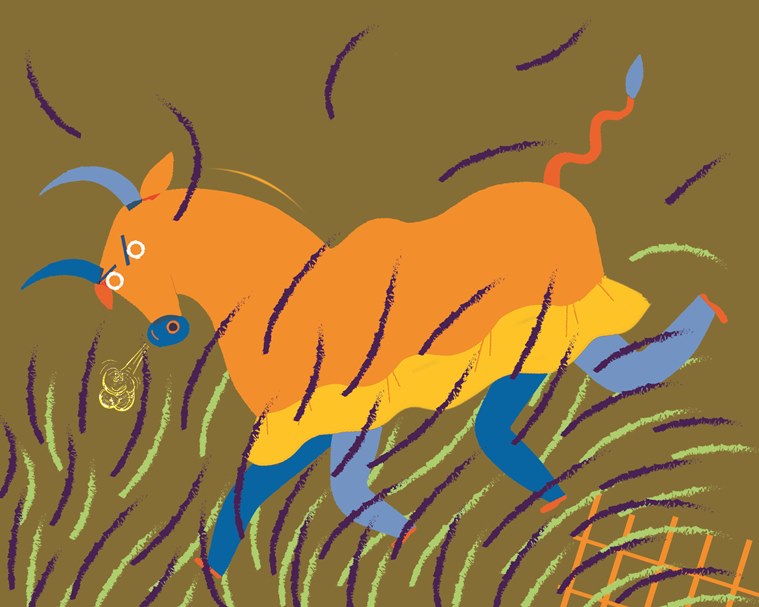- India
- International
UP holds huge potential in agriculture — it needs right leadership to forge forward-looking path
UP is truly at the crossroads: The state is uniquely poised to leverage opportunities from agriculture and build on the base laid by entrepreneurs, whether in sugar, potatoes, buffalo meat, leather or mentha oil. But, it is equally in danger of being taken back by decades, courtesy leaders with exclusivist and narrow-minded visions.
 What began as a crackdown on so-called illegal slaughterhouses has extended to forced closure of tanneries in Kanpur, ostensibly for the ardh kumbh mela from January 15 to March 4. (Illustration by C R Sasikumar)
What began as a crackdown on so-called illegal slaughterhouses has extended to forced closure of tanneries in Kanpur, ostensibly for the ardh kumbh mela from January 15 to March 4. (Illustration by C R Sasikumar)
Efforts to market it as an Uttam Pradesh notwithstanding, UP or Uttar Pradesh, is for many, an “Ulta Pradesh” — a place where nothing works, except in reverse. Even more disdainful is “U Pay” — things can work, provided you grease the right palms.
Whichever way one looks at it, something more than ordinary is needed for a state that houses 16.5 per cent of India’s people, and would be the world’s fifth-most populous, were it a country. And that’s probably best achieved by leveraging possibilities in agriculture and allied activities, which does not require starting from scratch. Instead, one could simply build on what already exists. Consider the following:
The whole of northern UP practically — from Upper Doab, Rohilkhand, Terai and the Awadh region just above Lucknow, to Kushinagar — grows sugarcane. The state has 120-odd operational sugar mills with cane crushing capacity aggregating over 7,80,000 tonnes per day, nearly half of it established in the last 15 years. Given that the country today is producing too much sugar and, simultaneously, importing the bulk of its oil requirements, why not encourage mills to manufacture ethanol fuel directly from cane juice? The Narendra Modi government’s National Biofuels Policy permits such direct conversion, as opposed to making ethanol only from the residual molasses after production of sugar. It has also targeted 20 per cent ethanol blending in petrol by 2030, against an actual all-India average of 4.2 per cent for 2017-18 (December-November) and a likely 7.2 per cent this year.
UP has already overtaken Maharashtra as India’s top sugar producer. The next goal should be to transform the state’s ganna belt into an ethanol powerhouse. Give mills the choice whether to crystallise the juice from their cane into sugar, or ferment it straight into alcohol for potable, industrial and fuel blending purposes. At current sugar prices, they would rather produce more ethanol, making it also easier to clear outstanding dues to cane growers (Rs 10,500 crore-plus in UP). It would further help if all taxes on ethanol used for fuel blending are removed; the government’s revenue interests can be protected by reserving a certain percentage of mills’ alcohol output for potable liquor.
Similar innovative thinking is necessary for UP’s potato belt, covering the Middle and Lower Doab regions from Mathura to Kanpur, and even districts such as Allahabad, Jaunpur and Barabanki. Like in ganna, there is an existing infrastructure for aloo in the form of cold stores. Agra, Hathras, Aligarh and Firozabad together have some 780 cold stores with a combined 65 lakh tonne space, again mostly created after 2000. When such large storage capacity allows freshly-harvested produce to be preserved for 8-9 months, what stops the government from formulating a policy to attract investments in potato processing? Processing needn’t just be chips and French fries; it can extend to flakes/powder, starch and even vodka.

In sugar, UP’s massive capacity additions during the mid-2000s was mainly driven by the then Samajwadi Party government’s policy of tax exemptions and incentives for both new mills and expansions. In aloo, where farmers are suffering low realisations for the last three years, what is required more than sops is firm government commitment not to impose curbs on stocking, processing or exports in the event of price rise. The Centre and state governments must understand the new reality of Indian agriculture —wherein shortages are increasingly episodic, not structural, and the ability of farmers to ramp up output in response to higher prices has vastly improved compared to, say, 20 years ago.
A cluster-based approach to attract agro-processing investments can also be adopted for Bundelkhand, a major pulses bowl. Production of rabi pulses in this parched region has received an added boost through farm ponds that can store rainwater accumulated during the monsoon season, and, use it to provide up to two protective irrigations, just enough for the winter chana (chickpea), matar (green peas) and masur (lentil) crops. In the last three years, more than 10,000 such ponds have been built in the seven Bundelkhand districts by farmers themselves, with the UP government subsidising 50 per cent of the cost. The results are clearly showing on the ground. The logical next step should be to ensure remunerative prices through government procurement and incentives for setting up dal mills and downstream processing units. Such interventions are likely to work better when they are region and crop-specific.
Another industry, whose worth hasn’t been appreciated, especially by the present ruling dispensation, is bovine meat. UP has 39 registered abattoirs that account for three-fourths of India’s annual $4 billion buffalo meat exports. Meat apart, a major byproduct of these modern plants, which have all come up in the last two decades, has been the increased availability of quality hide that is freshly flayed, fleshed, salted and folded for supply to tanneries. The abattoirs sell other byproducts as well — tallow (fat) to soap and lubricant units, bones to manufacturers of gelatin used in drug capsules, etc. Animal tallow is, incidentally, also identified as a raw material for bio-diesel production in the National Biofuels Policy!
However, forget recognising the potential of an industry that provides farmers a market for their spent buffaloes — enabling them to invest in new milk-yielding animals and making dairying viable — the Yogi Adityanath administration in UP has embarked on a path of destruction. What began as a crackdown on so-called illegal slaughterhouses has extended to forced closure of tanneries in Kanpur, ostensibly for the ardh kumbh mela from January 15 to March 4. The mela is over, but the tanneries are yet to reopen. We have a situation now of abattoirs in Aligarh and Unnao holding huge unsold stocks of raw hide, even as Agra’s shoemakers have switched to synthetic leather (basically polyurethane foam-coated fabric) imported from China.
UP is truly at the crossroads: The state is uniquely poised to leverage opportunities from agriculture and build on the base laid by entrepreneurs, whether in sugar, potatoes, buffalo meat, leather or mentha oil. But, it is equally in danger of being taken back by decades, courtesy leaders with exclusivist and narrow-minded visions who have turned the govansh into an enemy of farmers, devouring their standing crop (why not permit slaughter of at least crossbred cattle, having more foreign than desi blood?). The road from “Ulta” to “Uttam” Pradesh calls for a “Seedha” or straight-thinking approach.
This article first appeared in the print edition on May 14, 2019, under the title ‘Seedha vision for Ulta Pradesh’. harish.damodaran@expressindia.com
40 Years Ago
EXPRESS OPINION
More Explained
Apr 16: Latest News
- 01
- 02
- 03
- 04
- 05









































